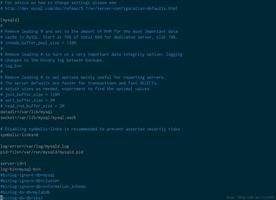C#根据反射和特性实现ORM映射实例分析
本文实例讲述了C#根据反射和特性实现ORM 映射的方法。分享给大家供大家参考。具体如下:
(一)关于反射
什么是反射?
反射就是在运行时,动态获取对象信息的方法。比如:运行时获得对象有哪些属性,方法,委托等。
反射的作用?
能够实现运行时,动态调用对象的方法,以及动态设置、获取属性值等。
反射的示例:
using System;
using System.Reflection;
namespace CS_Test
{
public class MyStudent
{
private string sName;
public string SName
{
get { return sName; }
set { sName = value; }
}
private int sAge;
public int SAge
{
get { return sAge; }
set { sAge = value; }
}
}
class Test_Attribute
{
[STAThread]
static void Main(string[] args)
{
MyStudent stu1 = new MyStudent();
stu1.SName = "刘德华";
stu1.SAge = 40;
// 获得所有属性
PropertyInfo[] pros = stu1.GetType().GetProperties();
// 显示所有属性值
foreach (PropertyInfo pro in pros)
Console.WriteLine(pro.Name+":"+pro.GetValue(stu1,null));
//更改stu1对象的SAge值
stu1.GetType().GetProperty("SAge").SetValue(stu1, 30, null);
// 显示所有属性值
foreach (PropertyInfo pro in pros)
Console.WriteLine(pro.Name+":"+pro.GetValue(stu1, null));
}
}
}
(二)关于特性
什么是 Attribute?
它是对运行时的对象或对象的属性、方法、委托等进行描述的类。
Attribute 的作用?
用于在运行时,描述你的代码或者影响你的程序的行为。
注意:
既然Attribute 是类,那么它的定义与定义类一样。
唯一不同的就是,自定义Attribute 类必须继承于System.Attribute 空间。
特性的示例:
//描述数据库字段的 Attribute
public class DataFieldAttribute : Attribute
{
public DataFieldAttribute(string fieldName,string fieldType)
{
this._fieldName = fieldName;
this._fieldType = fieldType;
}
// 数据库字段名
private string _fieldName;
public string FieldName
{
get { return _fieldName; }
set { _fieldName = value; }
}
// 数据库字段类型
private string _fieldType;
public string FieldType
{
get { return _fieldType; }
set { _fieldType = value; }
}
}
通过自定义Attribute,我们定义了类属性和数据库字段的一一对应关系,于是对MyStudent 类的Name、Age 属性都加上Attribute 的描述,指定他们对应的数据库字段名以及类型。
代码更改如下:
public class MyStudent
{
private string _name;
//使用“特性”描述对应的数据库字段名、类型
[DataFieldAttribute("SName", "varchar")]
public string Name
{
get { return _name; }
set { _name = value; }
}
private int _age;
[DataFieldAttribute("SAge", "int")]
public int Age
{
get { return _age; }
set { _age = value; }
}
}
(三)ORM 映射规则的定义
给实体类增加DataFieldAttribute 的描述,其实就是增加了O(对象)/ R(关系数据库)的映射规则。
下面我们就通过反射的方法实现:在运行时动态获取O/R Mapping 的映射规则:
static void Main(string[] args)
{
MyStudent stu1 = new MyStudent();
stu1.Name = "刘德华";
stu1.Age = 40;
//通过反射的方法来动态获取此映射规则
PropertyInfo[] infos = stu1.GetType().GetProperties();
object[] objs_fieldAttr = null;
foreach (PropertyInfo info in infos)
{
// GetCustomAttributes:
// 返回实体对象中每个属性对应的“特性”信息(数据库字段名、类型)
objs_fieldAttr = info.GetCustomAttributes(
typeof(DataFieldAttribute), false);
if (objs_fieldAttr != null)
{
Console.Write("实体类的属性名:" + info.Name);
Console.Write(" -> 数据库字段名:");
Console.WriteLine(((DataFieldAttribute)objs_fieldAttr[0]).FieldName);
}
}
}
显示结果:
实体类的属性名:Name -> 数据库字段名:SName
实体类的属性名:Age -> 数据库字段名:SAge
接下来的工作就是:怎样根据这种方法动态地从对象中获取映射规则,然后动态构造Insert、Update、Delete 等 SQL 语句。这就是实现自己的ORM 的原理。
这里的代码仅仅是举例,而要真正实现一个ORM,我们还需要考虑的很多,比如:
1、实体类对应于哪张数据库表?
2、数据库表中的 PK 和 FK(如果有的话)怎么表示?
完整代码如下:
using System;
using System.Reflection;
namespace CS_Test
{
public class MyStudent
{
private string _name;
//使用“特性”描述对应的数据库字段名、类型
[DataFieldAttribute("SName", "varchar")]
public string Name
{
get { return _name; }
set { _name = value; }
}
private int _age;
[DataFieldAttribute("SAge", "int")]
public int Age
{
get { return _age; }
set { _age = value; }
}
}
//描述数据库字段的 Attribute
public class DataFieldAttribute : Attribute
{
public DataFieldAttribute(string fieldName,string fieldType)
{
this._fieldName = fieldName;
this._fieldType = fieldType;
}
// 数据库字段名
private string _fieldName;
public string FieldName
{
get { return _fieldName; }
set { _fieldName = value; }
}
// 数据库字段类型
private string _fieldType;
public string FieldType
{
get { return _fieldType; }
set { _fieldType = value; }
}
}
class Test_Attribute
{
[STAThread]
static void Main(string[] args)
{
MyStudent stu1 = new MyStudent();
stu1.Name = "刘德华";
stu1.Age = 40;
// 获得所有属性
PropertyInfo[] pros = stu1.GetType().GetProperties();
// 显示所有属性值
foreach (PropertyInfo pro in pros)
Console.WriteLine(pro.Name+":"+pro.GetValue(stu1,null));
//更改stu1对象的SAge值
stu1.GetType().GetProperty("Age").SetValue(stu1, 30, null);
// 显示所有属性值
foreach (PropertyInfo pro in pros)
Console.WriteLine(pro.Name+":"+pro.GetValue(stu1, null));
//通过反射的方法来动态获取此映射规则
PropertyInfo[] infos = stu1.GetType().GetProperties();
object[] objs_fieldAttr = null;
foreach (PropertyInfo info in infos)
{
// GetCustomAttributes:
// 返回实体中每个属性对应的“特性”信息(数据库字段名、类型)
objs_fieldAttr = info.GetCustomAttributes(
typeof(DataFieldAttribute), false);
if (objs_fieldAttr != null)
{
Console.Write("实体类的属性名:" + info.Name);
Console.Write(" -> 数据库字段名:");
Console.WriteLine(((DataFieldAttribute)objs_fieldAttr[0]).FieldName);
}
}
}
}
}
希望本文所述对大家的C#程序设计有所帮助。
以上是 C#根据反射和特性实现ORM映射实例分析 的全部内容, 来源链接: utcz.com/z/334361.html








